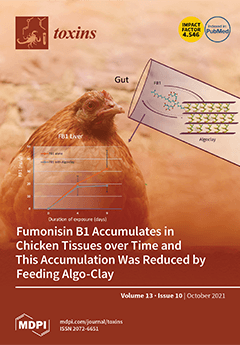Fusarium head blight (FHB) is a devastating wheat disease, mainly caused by
Fusarium graminearum (FG)—a deoxynivalenol (DON)-producing species. However,
Fusarium avenaceum (FA), able to biosynthesize enniatins (ENNs), has recently increased its relevance worldwide, often in co-occurrence with FG. While DON is a well-known
[...] Read more.
Fusarium head blight (FHB) is a devastating wheat disease, mainly caused by
Fusarium graminearum (FG)—a deoxynivalenol (DON)-producing species. However,
Fusarium avenaceum (FA), able to biosynthesize enniatins (ENNs), has recently increased its relevance worldwide, often in co-occurrence with FG. While DON is a well-known mycotoxin, ENN activity, also in association with DON, is poorly understood. This study aims to explore enniatin B (ENB) activity, alone or combined with DON, on bread wheat and on
Fusarium development. Pure ENB, DON, and ENB+DON (10 mg kg
−1) were used to assess the impacts on seed germination, seedling growth, cell death induction (trypan blue staining), chlorophyll content, and oxidative stress induction (malondialdehyde quantification). The effect on FG and FA growth was tested using ENB, DON, and ENB+DON (10, 50, and 100 mg kg
−1). Synergistic activity in the reduction of seed germination, growth, and chlorophyll degradation was observed. Conversely, antagonistic interaction in cell death and oxidative stress induction was found, with DON counteracting cellular stress produced by ENB.
Fusarium species responded to mycotoxins in opposite directions. ENB inhibited FG development, while DON promoted FA growth. These results highlight the potential role of ENB in cell death control, as well as in fungal competition.
Full article






